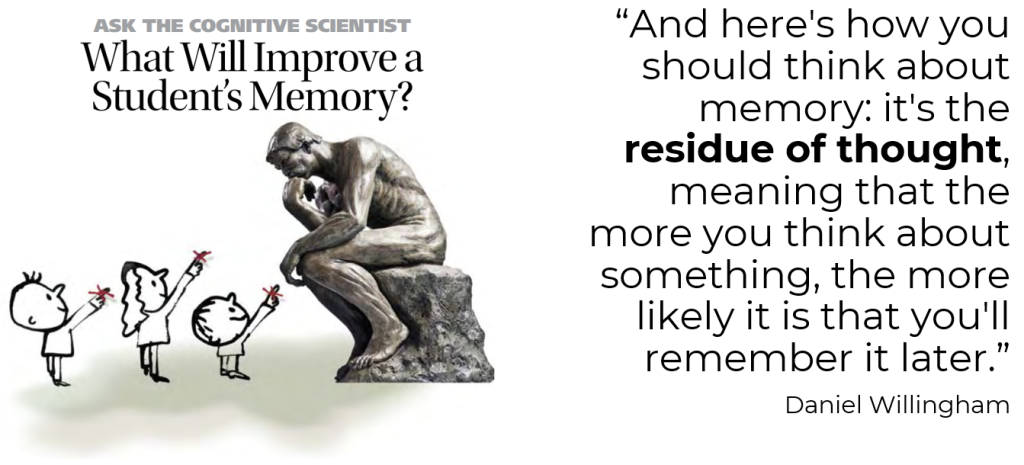Earlier this year I catalogued the many insights gleaned from educational experts which have been most influential in my curriculum thinking, in a post entitled, This much I know about… the principles of curriculum planning in action. In a series of short essays I am exemplifying in more detail ten of those influential insights, and explaining why I think they are so important to progressing pupils’ learning. This post explores inclusive, engaging teaching – that is teaching where every pupil has to engage with what is being taught and think hard about it (Dylan Wiliam).
‘If you leave students out because of your anxiety about their anxiety, you’re no use to them. You’re not carrying them; you are leaving them behind.’ (Tom Sherrington)
If learning is a permanent change to a pupil’s long-term memory and memory is the residue of thought, then getting pupils to think hard is key to progressing their learning.

So, teaching so that all pupils think hard is the challenge facing all teachers; getting it right is an incredibly complex process. One of the things we have to do is keep the pressure on pupils so that they might, at any one time, be asked to contribute to class discussion or explain what they have been thinking.
‘”Pressure on pupils” that’s outrageous – is the man so out of touch that he doesn’t know we have a mental health crisis on our hands?’ I hear you cry. Well, I wrote a book on mental health in schools back in 2017 and in 18 years as a headteacher I learnt a great deal about young people’s mental health. And I recently interviewed Sir Simon Wessely, Regius Professor of Psychiatry at KCL about teenage mental health and he said that the evidence says there has been a rise in mental health issues for 16-24 year old females. Despite that, I do think we have to create safe, humane conditions in our classrooms where everyone feels happy to contribute.
Creating a classroom environment where every pupil is able to discuss freely what they are learning is a major responsibility of our job. Here are three things you might do when asking pupils questions to create a culture where everyone is thinking hard:
- Enact Cold Calling with fidelity. Ask the question to the whole class. Tell them you will take at least three responses (‘at least’ means that even when you have asked the third pupil to contribute, you could ask another one or more…). Give them time to think and even make notes on a mini-whiteboard. Select a pupil. Ask them what they’re thinking (not what the answer is – introducing the idea of right/wrong at this stage can be intimidating, and everyone can think…and don’t fall into the trap of rubbing your hands together whilst scouring the room and saying with glee, ‘Right, who’s my next victim?’ or something similarly crass). Ask follow up questions to clarify thinking. Bounce the response around the room until you have asked at least the number of pupils originally specified. Tom Sherrington’s post on the detail of how to Cold Call effectively is helpful.
- Be primed with a number of tactics to counter the inevitable ‘Dunno’ response. Every teacher in your school will have ways of dealing with such a response – why not pool your ideas? Certainly ask the pupil to listen to the next pupil’s response and then ask them to repeat what that next pupil says and then build upon it. One approach that I have heard is helpful (but have not tried myself) and might be worth exploring is as follows…if a pupil says ‘Dunno’ in answer to a question, say straight back, with a straight face, ‘But if you did know, what would you say?’ Apparently, it works a treat!
- Set up a Think, Pair, Share, with deliberate care. Make sure your more more fragile pupils are partnered with a sensitive peer who can help them develop their thinking in a discussion, rather than tell them didactically a definitive answer. The discussion helps the vulnerable pupil develop their thinking. If you are circulating as they converse, you might hear less confident pupils say something great. Ask them, quietly, to repeat their thoughts to the whole class. Do it gently. Repeat their words out loud if they have a quiet voice. Lavish them with praise. Watch them grow as you do…
There seems to me to be no alternative to pupils thinking hard if they are going to learn. I worked with a school recently that implemented an approach to questioning which insisted there was no opt out of answering teachers’ questions. It wasn’t easy. When they pushed pupils to answer, the parents complained; they didn’t want the teachers to ask their children questions. The teachers refused to acquiesce. The SLT explained to parents that if they were asking for the teachers not to ask their children to answer questions, they were, in essence, asking them not to educate their children.
Without the pressure of potentially being asked to discuss what they have been learning (and thus being allowed not to have to pay attention nor think about what is being taught) pupils may as well be in the corridor than in the classroom.


NB: This point by Dylan Wiliam adds an important nuance to my argument. Pupils can’t think about nothing – you have to give them valuable content to think about…
‘The big mistake we have made… is to assume that if we want students to be able to think, then our curriculum should give our students lots of practice in thinking. This is a mistake because what our students need is more to think with.’

